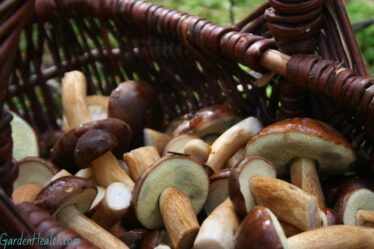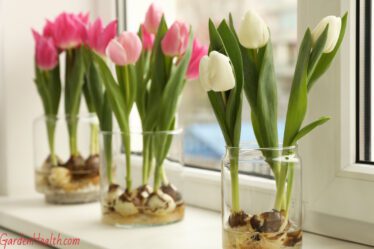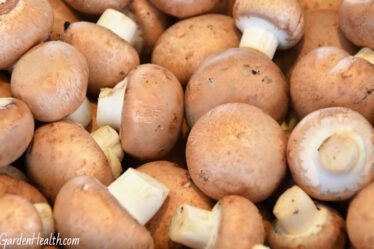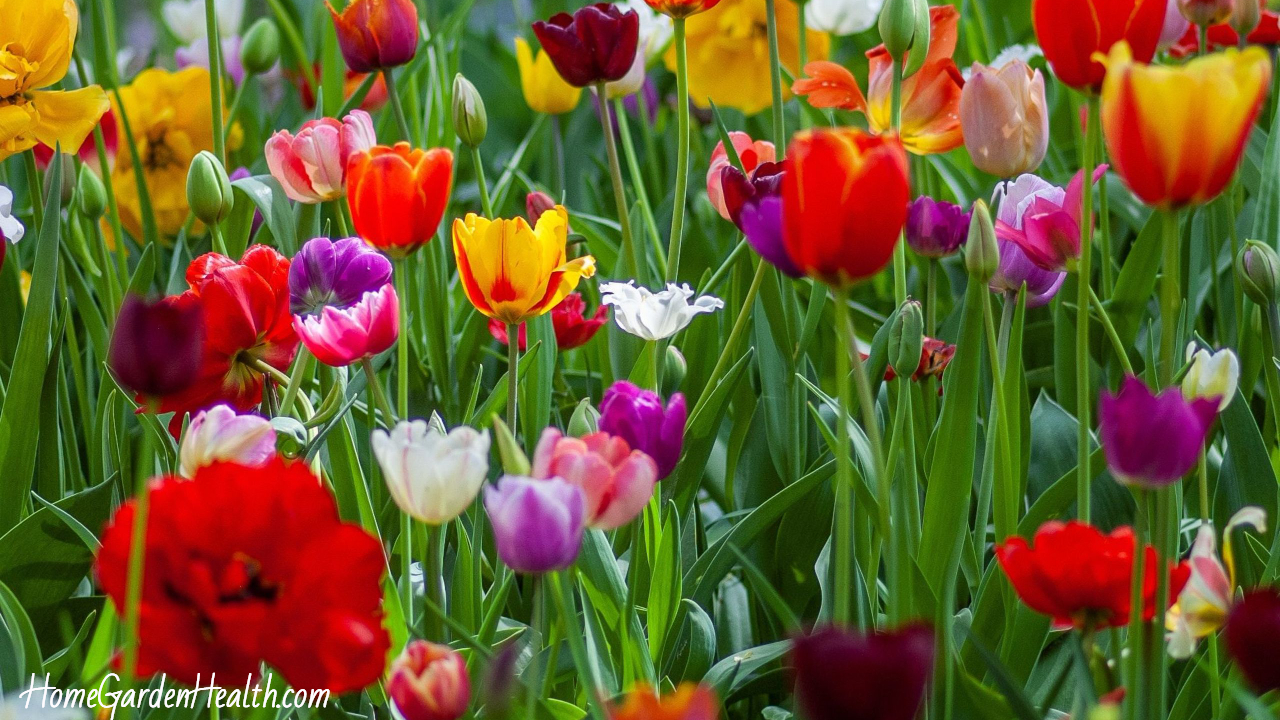
So, you’re thinking about growing tulips at home? Great choice! I mean, who could resist their vibrant colors and elegant shapes, right? Tulips can instantly jazz up your garden, adding that splash of color that can make your neighbors go “wow”. But hey, it’s not just about the visual appeal. There’s something incredibly soothing about gardening. It’s like therapy, without the hefty price tag. Imagine a stressful day melting away as you tend to your tulips. Sounds nice, doesn’t it?
And here’s another cool thing about having tulips around your home – they’re like mini air purifiers! By absorbing carbon dioxide and releasing oxygen, they help freshen up the air we breathe.
But, the benefits aren’t just for us humans. By creating a little tulip oasis, you’re also supporting your local ecosystem. Who knew gardening could feel so rewarding, right? And speaking of rewarding, nothing quite beats the feeling of watching a bulb transform into a beautiful tulip. It’s a learning experience and gives you a sense of accomplishment.
Plus, if you ever decide to sell your property, that well-tended garden can potentially bump up your property value. And let’s not forget the endless supply of gorgeous bouquets you can create with your home-grown tulips. Imagine surprising your loved ones with a handpicked tulip bouquet. Now that’s a gift from the heart!
So, as you can see, growing tulips at home has so many perks. It’s not just a hobby; it’s an investment in your health, happiness, and even your home’s curb appeal. Happy gardening!
Tulip Time Machine: Exploring the Past and Present of These Stunning Blooms
Did you know that tulips have a fascinating history? They weren’t always the backyard staples we know them as today. Originating from Central Asia, they journeyed across continents and centuries to find a home in our gardens. In the 16th century, tulips were brought from Turkey to Holland, where they triggered something called “Tulip Mania”. People were so enamored by these colorful blooms that they traded them like precious gems!
And can you blame them? With their wide range of colors and shapes, there’s a tulip for every taste. Let’s chat about some of the varieties, shall we? First off, we have the Single Early Tulips. They’re the early birds of the tulip world, showing up in the garden while it’s still spring. With their bright colors, they’re like little suns on stems.
Then there are the Double Late Tulips, the show-offs. Seriously, these guys look like they belong in a royal garden. Their large, peony-like blooms are quite the spectacle. Want something a bit more elegant? Try the Lily-flowered Tulips. Their pointed petals and tall, slender stems make them the ballerinas of the tulip family.
Honestly, the variety of tulips is like a rainbow—there’s something for everyone. Whether you’re into vibrant reds, cool purples, sunny yellows, or even mysterious blacks, tulips got you covered. So, no matter your garden’s theme or your personal taste, there’s a tulip out there just waiting for you to plant it. Isn’t that just awesome?
Planting Tulips: Ground or Pots? Choosing the Perfect Method for Your Blooming Delights
So, you’ve got your tulip bulbs and you’re all set to go. But now comes the big decision: do you plant them in your garden soil or in pots? Well, both methods have their own charm, and the choice really depends on what you’re looking for.
Let’s start with planting in the garden. The first step is to pick a sunny spot – tulips love the sun! But here’s the catch: your garden soil can’t just be any old dirt. Tulips need well-draining soil to avoid bulb rot. So, you might need to do some digging and turning over your garden to prepare it. The secret ingredient here is compost. Mixing in some compost will not only improve the soil’s structure, making it better drained, but also enrich it with nutrients. Yes, it’s a bit of work, but trust me, it’s worth it.
On the other hand, if you’re short on space or just want to avoid all that digging, pots are a great option. Tulips in pots can be just as stunning, and you have the added benefit of mobility – you can move your tulip display around to catch the sun or to show them off to visitors! Just make sure you pick a pot that’s deep enough for the bulbs (about twice their height), and use a high-quality potting mix that drains well.
So, whether you choose to get down and dirty with garden planting or keep things neat with pots, tulips are super adaptable. Plus, there’s something incredibly satisfying about both methods. Whether it’s watching your garden transform with a sea of color or enjoying the sight of blooming tulips on your patio, either way, you’re in for a treat. So, ready to get planting?
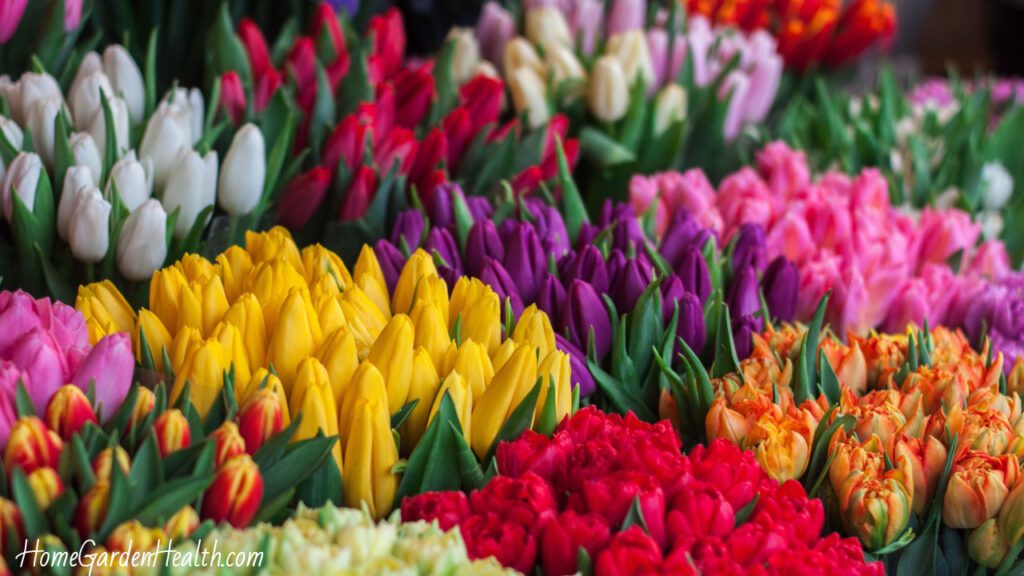
Blossoming Beauty: Mastering the Art of Selecting Tulip Bulbs for a Vibrant Garden
So, it’s time to dive into the exciting world of selecting tulip bulbs, the true stars of your garden! We understand that the abundance of choices can be overwhelming, with rows upon rows of bulbs beckoning at the store. But fear not, for we have a trick up our sleeve. When picking out tulip bulbs, look for those that are firm, plump, and with the skin intact. These are signs of healthy bulbs that are bursting with potential. Remember, size matters too! The larger the bulb, the bigger and more impressive the flower will be when it blooms, so don’t be afraid to go for those robust bulbs that catch your eye.
Now comes the fun part: selecting the tulip varieties that will grace your garden. This is where you can let your creativity flourish. With a wide range of options available, you can choose to create a mesmerizing display of Single Early tulips, bursting forth in vibrant colors and announcing the arrival of spring. Or perhaps you prefer a mix of different tulip varieties, creating a tapestry of hues and styles that will leave your garden bursting with life and personality. The choice is yours, and there are no limits to the beauty you can cultivate.
Growing Gorgeous Tulips: Your How-To Guide for Proper Care
So, you’ve got your tulips planted – great job! But now comes the part where you need to nurture those little bulbs into blooming beauties. And the first step to that? Watering. Now, you might be thinking, “Oh, I just need to keep the soil wet, right?” Well, not quite. Tulips aren’t big fans of soggy soil. Instead, aim to keep the soil moist, especially during dry spells. Overwatering can lead to bulb rot, and we definitely don’t want that. So, go easy on the watering, okay?
Next on the list is fertilizing. Now, don’t panic, it’s not as complicated as it sounds. Tulips aren’t super demanding when it comes to fertilizer. In fact, a good helping of compost or well-rotted manure at planting time can often be enough. But if your soil isn’t rich in nutrients, a slow-release bulb fertilizer can give your tulips a boost. Just follow the instructions on the package, and you’re good to go.
Now, let’s talk pruning. Once your tulips have flowered, you might be tempted to cut off the foliage when it starts to turn yellow. But hold your shears! The tulip needs its leaves to gather energy for next year’s flowers. So, let them die back naturally before you remove them. And of course, feel free to cut tulip flowers for vases, but leave the leaves in place.
As you can see, caring and growing tulips at home doesn’t require a degree in botany – just some attention to watering, fertilizing, and pruning. Before you know it, you’ll have a garden full of colorful, blooming tulips to show for your efforts.
From Garden to Vase: The Perfect Time and Method for Harvesting Tulips
First off, when are tulips ready to harvest? Well, it’s all about the bloom. Once your tulip flowers are fully formed and just starting to open, that’s your cue. You might be tempted to wait until they’re fully open, but trust me, cutting them at the start of their bloom will give you the longest vase life. Plus, there’s something magical about watching the petals slowly unfurl in your vase, right?
Now, onto the how. When it comes to cutting your tulips, you’ll want to be gentle and careful. Use a clean, sharp pair of garden shears or a knife to cut the stem. And here’s a pro-tip: cut your tulips early in the morning or late in the day. The cooler temperatures will keep your flowers fresher for longer.
As for where to cut, aim for about an inch from the base of the stem. But remember, leave the leaves! They’ll gather energy from the sun and feed the bulb for next year’s flowers. It’s like your tulip’s own little solar panel system!
You’re now ready to harvest your home-grown tulips. Whether you’re decorating your own home or gifting them to someone special, there’s something so rewarding about a bouquet of tulips you’ve grown yourself.
Bulb Bonanza: Your Guide to Storing and Replanting Tulip Bulbs
So, your tulips have bloomed, brightened up your days, and the flowers have finally faded. But wait, the journey doesn’t end here! Those tulip bulbs can be a gift that keeps on giving, with a little love and care, of course.
When it comes to storing tulip bulbs, timing is everything. Wait until the foliage has turned yellow and died back naturally. This is when the bulb has gathered all the energy it needs for next year. Then, carefully dig up the bulbs, being extra careful not to damage them. Brush off any soil, remove the dead leaves and let them dry out for a day or two in a cool, shady spot.
Now that your bulbs are ready, it’s time for storage. A paper bag or a net bag works great. Store them in a cool, dry, and dark place. And remember, no moisture! We don’t want any moldy surprises when it’s time to replant.
Speaking of replanting, here are a couple of tips. First off, always inspect your bulbs before you replant them. Discard any that are soft or show signs of disease. It’s like spring cleaning for your bulbs! When you’re ready to plant, follow the same steps as the first time around. Remember, tulips love a sunny spot and well-drained soil. And, of course, the rule of thumb when planting is to place the bulb three times as deep as its height.
So, with these tips and tricks, your tulips can grace your garden year after year. It’s a little more work, but trust me, when those first shoots pop up from the soil in spring, it’s all worth it!
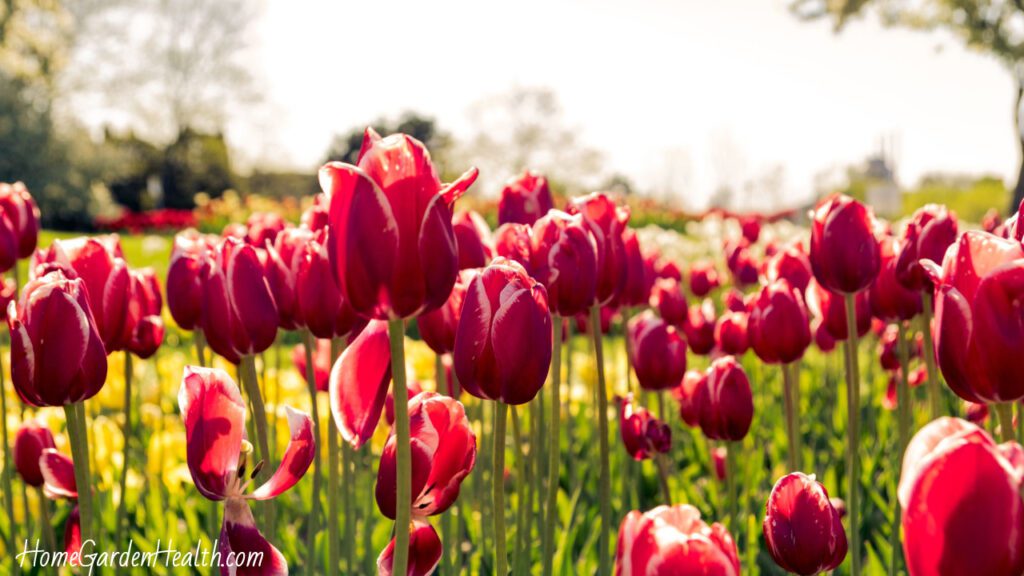
Defending Your Tulips: Battling Pests and Diseases in the Garden
Just like any garden endeavor, growing tulips at home can come with its own set of challenges. Yes, I’m talking about those pesky pests and diseases. Don’t worry though, with some knowledge and vigilance, you can keep your tulips healthy and blooming.
First up on the common offenders list are aphids. These little critters can cause your tulip leaves to curl and stunt the growth of your plant. And then we have bulb mites. They’re tiny, but can do big damage by causing the bulbs to rot. And let’s not forget about squirrels. These furry creatures might look cute, but they love to dig up and munch on tulip bulbs.
On the disease side, there’s tulip fire, a fungal disease that causes spots on leaves and stunted growth, and bulb rot which can occur if your bulbs are sitting in waterlogged soil.
Now, that might all sound a bit scary, but don’t fret. There are steps you can take to prevent and treat these issues. For starters, a healthy plant is your best defense. This means planting in well-draining soil, watering correctly, and giving your tulips the right amount of sunlight.
For pests, consider introducing beneficial insects like ladybugs into your garden, who love to snack on aphids. As for those bulb-loving squirrels, consider protective mesh or simply planting daffodils nearby, which squirrels tend to avoid.
As for diseases, good garden hygiene can go a long way. Remove and discard any affected plants to prevent the disease from spreading. And remember, never water your tulips from above as damp leaves can encourage fungal growth.
It might seem like a lot, but don’t let it deter you. Yes, pests and diseases are a part of the gardening journey, but they’re no match for a prepared gardener like you.
The Final Petal: Concluding Thoughts on Succesfully Growing Tulips at Home
Wow, we’ve been on quite the journey together, haven’t we? We dived into the vibrant world of tulips, learned about their fascinating history, and explored their stunning variety. You discovered what you need to get started: the tools, the bulbs, and a hefty dose of enthusiasm.
We then dug into the nitty-gritty of planting, both in the garden and in pots. I shared with you the watering, fertilizing, and pruning care tips your tulips need to thrive. And we chatted about the joy of harvesting your very own tulip blooms, and how to store and reuse those precious bulbs for more seasons of color.
So now, my dear gardening friend, it’s over to you. With all this tulip know-how, you’re more than ready to start your “growing tulips at home adventure”. Whether you want to brighten up your garden, your patio, or even your indoor space, there’s a tulip just waiting for you to plant it.
Remember, gardening is not just about the destination (those gorgeous tulips), but also about the journey. So, enjoy every moment, from the first bulb planted to the last tulip harvested. And remember, each tulip in your garden is a reflection of your love and care. So here’s to you, the soon-to-be tulip expert. Happy gardening!
Check out our Guide To Growing Tulips Indoors in Glass Vases
Tulip Tips Uncovered: Tackling Your Most Frequently Asked Questions
When is the best time to plant tulip bulbs?
Generally, you want to plant tulip bulbs in the fall, around 6 weeks before the first deep frost is expected. This gives the bulbs time to establish roots before winter sets in.
Can tulips grow in shade?
Tulips love the sun, and they do best in a spot that gets at least half a day of sunlight. However, they can tolerate some shade, especially in hotter climates.
How often should I water my tulips?
Unlike some plants, tulips don’t need constant watering. You want to keep the soil moist, but not waterlogged. So, aim for watering once a week or so, or when the top inch of soil is dry.
Why didn’t my tulips bloom?
There could be several reasons. It might be that the bulbs were damaged or diseased, the tulips didn’t get enough sun, or they weren’t planted deep enough. Don’t be disheartened, though. Growing tulips at home is all about learning and trying again.
Can I grow tulips indoors?
Absolutely! As long as you can provide them with plenty of light, such as by a south-facing window, tulips can be grown in pots indoors. Just remember that they still need a period of cold dormancy, so you’ll need to chill the bulbs in the refrigerator for 12-16 weeks before planting.
Remember, no question is a silly question when you’re learning something new. So fire away if you have any questions about growing tulips at home, we will do our best to answer them!
happy gardening!
References
https://en.wikipedia.org/wiki/Tulip







